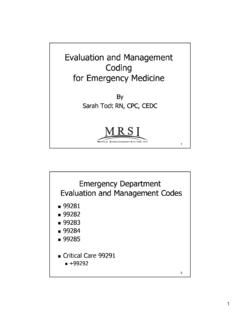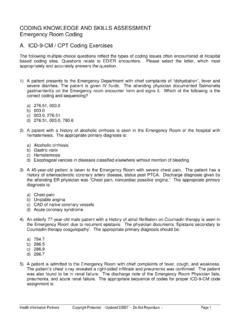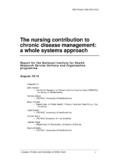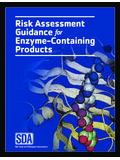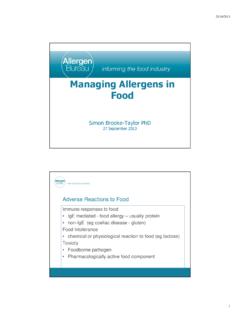Transcription of Case Studies on ED Management of Asthma - …
1 case Studies on ED case Studies on ED Management of AsthmaManagement of AsthmaCarlos Camargo, MD, DrPHEmergency Medicine, MGH Channing Laboratory, BWHH arvard Medical School2 Outline of PresentationOutline of Presentation NAEPP guidelinesNAEPP guidelines Initial assessment and diagnosisInitial assessment and diagnosis Treatment of Asthma exacerbationsTreatment of Asthma exacerbations Secondary prevention after the ED visitSecondary prevention after the ED visit3 NAEPP Guidelines, 1997 National Asthma Education and Prevention Program (NAEPP) Classification of chronic Asthma : Mild intermittent Asthma Mild persistentasthma(>2 days/wk, >2 nights/mo) Moderate persistent Asthma Severe persistent Asthma Inhaled corticosteroids (ICS) are preferred treatment for all patients with persistent asthma42002 Update on Selected Topics2002 Update on Selected Topics Antibiotics not recommended for acute Asthma ICSare preferred treatment for children of all ages with persistent Asthma ICS +long-acting -agonist(LABA) is the preferred treatment for moderate or severe persistent Asthma in individuals age 6 and olderNAEPP, 20025 Nelson, et al.
2 ;106(6):1088-1095. 2000. Reproduced with permission from the American Academy of Allergy, Asthma , and Therapy With ICS + LABA (days)6 Dual Therapy With ICS + LABA (weeks)Nelson, et al. ;106(6):1088-1095. 2000. Reproduced with permission from the American Academy of Allergy, Asthma , and for Improving Asthma 2 million emergency department (ED) visits per year Among ED patients: 74% adults (63% children) use ED for all problem Asthma care 45% adults (31% children) receive all Asthma Rx from ED With primary care physician (PCP): 63% + 61% for problem care; 24% + 25% for all Rx High-risk population 60% report history of Asthma hospitalization (15% report intubation) 80% to 90% report 1 or more ED visits for Asthma in past year However, only 45% are on 1: Recurrent Bronchitis 6 year old girl presents to ED with mild bronchitis History: Symptoms began 3 days ago initial upper respiratory infection (URI) symptoms that progressed to nocturnal cough & mild dyspnea on exertion (DOE).
3 Otherwise, well. Two to three bouts/year of bronchitis that require medical care (mist + over-the counter (OTC) beta-agonist inhaler, occasional 5-day course of steroids) Two ED visits last year, no prior hospitalizations for her bronchitis Physical exam: Respiratory rate (RR), normal heart rate (HR) & blood pressure (BP), normal temperature (T) Not using accessory muscles. No stridor End-expiratory wheezing all fieldsUnderdiagnosis of Asthma in Children Asthma onset usually before age 6 Commonly misdiagnosed as: Recurrent or chronic bronchitis Recurrent croup, URI, or pneumonia Wheezy bronchitis Reactive airway disease Children with mild Asthma accounted for one third of cases in fatal Asthma registryRobertson, et al Pediatr ;13(2) Assessment and Diagnosis Determine that: Patient has episodic signs/symptoms of airflow obstruction Alternative diagnoses are excluded (eg, vocal cord dysfunction, foreign bodies, other cardiopulmonary diseases) Methods for establishing diagnosis: Medical history & physical exam Referral for spirometry (including forced expiratory volume in 1 second (FEV1), forced vital capacity (FVC), reversibility)1011 Measurement of Airflow Obstruction Asthma severity (acute or chronic) is very difficult to determine by symptoms & physical exam.
4 Measure by one of the following: Peak expiratory flow (PEF, using peak flow meter) FEV1(spirometry) PEF tends to give higher % predicted than FEV1(ie, PEF tends to underestimate attack) Need table of PEF values for children (ages 6 to 17)12 Peak Expiratory Flow (Adults)Severity per 1997 NAEPP (% predicted):Severe (<50) .. Moderate (50-79) .. Mild (80+)PEF (L/min)SeverityPEF %WomenMenAdjunct Rx<40<200<25040-69200-299 250-399 Discharge goal70+300+400+13 case 2: Intermittent Asthma 20 year old man presents with allergy problems History: Hayfever acting up x 3 days .. onset mild shortness of breath (SOB) yesterday, not responding to OTC allergy meds (including inhaler) Uses OTC inhaler before & after workouts, plus 1 night/week Multiple infections as child, occasional allergy problems, told by MD that he might have Asthma but never confirmed 3 ED visits last year, no prior hospitalizations for his allergies Physical exam:_RR, HR, normal BP, normal T PEF 325 (What % predicted?)
5 250/400 .. approx 55%) Nasal congestion. Diffuse wheezing14ED and Hospital Management : ED and Hospital Management : GoalsGoals1. Correct significant hypoxemia2. Rapidly reverse airflow obstruction3. Decrease likelihood of recurrenceNAEPP, 199715ED and Hospital Management : ED and Hospital Management : Initial TreatmentInitial TreatmentMildMild--toto--Moderate Exacerbation (PEF Moderate Exacerbation (PEF >>50%)50%) Oxygento achieve O2sat >90% Inhaled 2-agonistby metered dose inhaler (MDI) or nebulizer (neb), up to 3 times in first hour Oral corticosteroidif no immediate response or if patient recently took oral corticosteroidNAEPP, 199716 -Agonists Albuterol neb mg / 4-5 cc NS 2-selective & longer acting Nebulizer vs. MDI therapy Repeat q 20 minutes x 2, then .. Attempt switch to MDI/spacer 4 to 10 puffs q1h prn Consider continuous neb (10 to 20 mg/hr) for patients with PEFR <40% Do not use IV or SQ -agonists instead ofinhaled.
6 Sparse data on concomitanttherapy (eg, adding terbutaline mg SQ) ..Cates, et al. Cochrane Database Syst ;(2):CD000052. Camargo, et al. Cochrane Database Syst ; in press. Travers, et al. ;122 Corticosteroids Prednisone 40-60 mg po if: Outpatient steroids / recent taper, or Initial peak flow (PF) <70% (W <300, M <400), or 1-hour PF with <10% improvement Make steroid decision in <1 hour No advantage from using high-dose .. also, PO = IV Systemic steroid Rx at discharge: Fixed (prednisone 50 mg x 5 d) vs taper (multiple options) Ideal regimen not known, probably 5-10 days; taper if >7 days Consider IM methylprednisolone (Depo-Medrol) 80 mg to 120 mg for potentially noncompliant patientsRowe et al. Cochrane Database Syst ;(2):CD000195. Rowe et al. Cochrane Database Syst ;(2) Management ? Remember NAEPP Goal 3: Decrease likelihood of recurrence Per NAEPP guidelines: He has persistentasthma Preferred therapy = inhaled corticosteroids He needs Asthma education& outpatient follow-up More on this shortly.
7 NAEPP, 199719 case 3: Severe Acute Asthma 35 year old woman presents with severe Asthma attack History of present illness & meds: URI x few days .. very SOB x 2 hours before ED presentation On albuterol & ipratropium prn, and ICS (+compliance) Asthma diagnosis at age 25. Has PCP & Medicaid insurance 2 ED visits last year + Asthma hospitalization, + intubation Physical exam: RR, HR, normal BP, normal T PEF 150 (<40% predicted) Diffuse wheezing despite poor air movement20ED and Hospital Management :ED and Hospital Management :Initial TreatmentInitial TreatmentSevere Exacerbation (PEF <50%)Severe Exacerbation (PEF <50%) Oxygento achieve O2 sat >90% Inhaled high-dose 2 -agonistand anticholinergicby neb q 20 minutes or continuously for 1 hour Oral corticosteroidNAEPP, 199721ED and Hospital Management :ED and Hospital Management .
8 Initial Treatment Initial Treatment (continued)(continued)Impending or Actual Respiratory ArrestImpending or Actual Respiratory Arrest IntubationIntubationand and mechanical ventilationmechanical ventilationwith with 100% O100% O2 2 NebulizedNebulized 2--agonistagonistand and anticholinergicanticholinergic IV corticosteroidIV corticosteroid Admit to hospital intensive careAdmit to hospital intensive careNAEPP, 199722 Inhaled Inhaled AnticholinergicsAnticholinergics Moderate bronchodilation Delayed onset (>20 minutes) Peak effect at 30 to 60 minutes Of likely benefit for: Severe (refractory) exacerbations, especially children Older patients with Asthma -COPD Ipratropium neb mg / 4-5 mL NS Available as neb or MDI Q 20 to 30 minutes x 3 may be most effective, then q 2 to 4 hoursStoodley, et al. Ann Emerg ;34(1) Sequence Rapid Sequence IntubationIntubationIf extreme respiratory distress, with hemodynamicinstability or change in mental status: Sedation Midazolam 5 mg IV.
9 Or ketamine 100 mg IV Cough suppression Lidocaine 100 mg IV Paralysis Succinylcholine 100 mg IV .. or vecuronium 10 mg IV Oropharyngeal intubation with 8-mm tube24 Novel Therapies in the ED IV magnesium Heliox Others ICS in acute setting IV montelukast Bronchoalveolar lavage25IV Magnesium for Acute Asthma Admit RateRowe, et al. Ann Emerg ;36(3):181-190. 2000. Reproduced with permission from The American College of Emergency Severe Acute Asthma for Severe Acute Asthma PEFPEFKass, et al. ;116(2) with permission. 27ED-Initiated Preventive Interventions High-risk population Use of ED for problem Asthma care + Asthma Rx What interventions are feasible in the ED setting? Examples from MARC:1. ICS initiation at discharge from ED2. Asthma education programs3. Bridging the gap between ED & primary Asthma careEMNet after the ED ICS after the ED Relapse at Relapse at 20 to 24 Days20 to 24 DaysEdmonds, et al.
10 Cochrane Database Syst ;(3) with permission. Cochrane , et al. Arch Intern Med2002;162(14) with permission. 2002, American Medical of Repeat ED Visits30 Suissa S, Ernst P. N Engl J Med. 2000;343(5) with permission. Copyright 2000 Massachusetts Medical Society. All rights of Fatal of Inhaled Corticosteroids per YearRate Ratio of Asthma Death131 Mission StatementMission StatementTo promote optimal Asthma Management and quality of life among individuals with Asthma , their families and communities, by advancingexcellence in Asthma education through theCertified Asthma Educator Asthma Educator Certification with PCP Philadelphia study Randomized trial, 1 center, N = 178 $25 intervention (free meds, taxi vouchers, 48-hr call) Follow-up with PCP: usual care (29%) vsintervention (46%), P=.02; RR= (95% CI, ) EMF Center of Excellence Award Recently completed RCT at 9 EMNet sites 1 month: 50%increase in PCP follow-up (ACEP 2001)Baren, et al.





